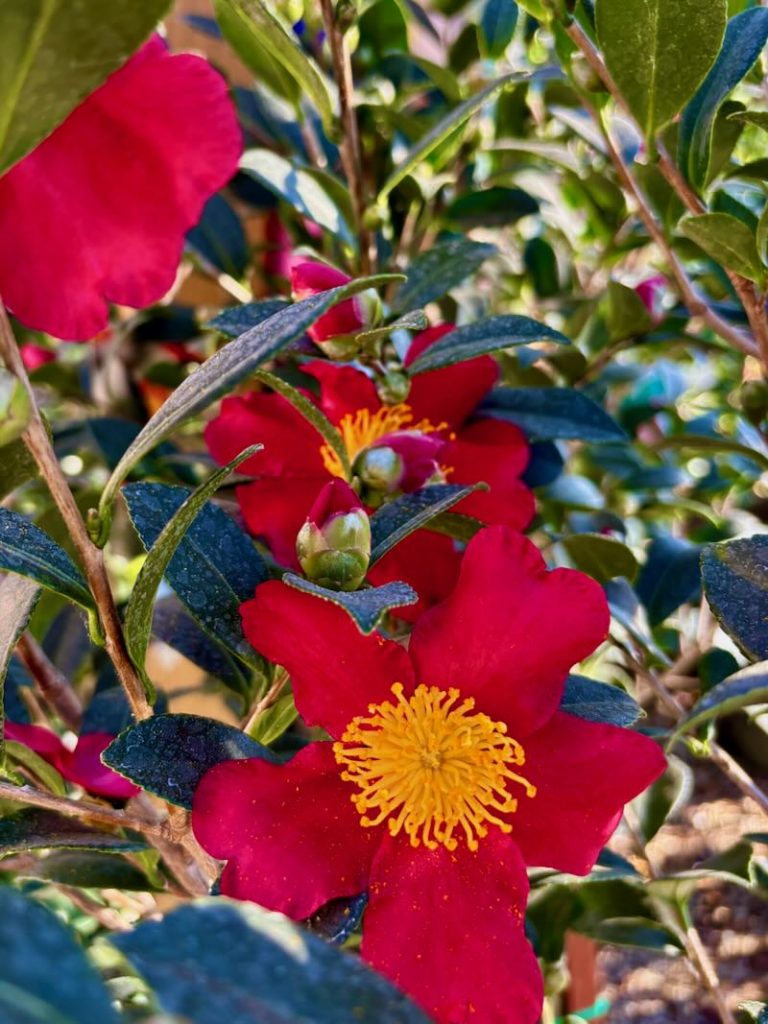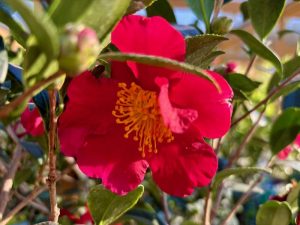Holiday Brilliance in Bloom: Discover the Beauty of Camellia sasanqua ‘Yuletide’
Camellia sasanqua ‘Yuletide’, commonly known as the ‘Yuletide’ Camellia, brings a spectacular burst of color to the quiet winter garden. While most flowering shrubs fade into dormancy as the cold sets in, ‘Yuletide’ is just beginning its show—unfolding vivid crimson petals and golden stamens against a lush backdrop of evergreen foliage. This compact, upright camellia is more than a winter novelty; it’s a striking performer with timeless elegance.
Belonging to the Theaceae family, Camellia sasanqua ‘Yuletide’ is a revered cultivar of the sasanqua camellias, a species native to Japan. Gardeners have embraced this variety for its luminous winter blossoms, manageable growth habit, and glossy dark green leaves that persist year-round. It offers the rare gift of color during months that are otherwise gray, making it a staple in winter landscapes, foundation plantings, and containers alike.
Camellia sasanqua ‘Yuletide’: A Plant That Celebrates the Season
As its name suggests, ‘Yuletide’ is synonymous with holiday spirit. It begins blooming in late autumn and often continues into January or even early February, depending on the climate. The flowers—brilliant scarlet with cheerful yellow centers—feel almost festive in appearance, like nature’s ornaments hung delicately among the deep green foliage. Each bloom measures approximately 2.5 to 3 inches (6 to 7.5 cm) across, and though the flowers are single, their sheer quantity creates a dazzling effect.
This camellia isn’t just about looks. With a mature height of 8 to 10 feet (2.4 to 3 meters) and a spread of 6 to 8 feet (1.8 to 2.4 meters), ‘Yuletide’ maintains a narrow, upright habit that makes it easy to fit into most garden settings. Whether trained as a hedge, pruned into a small tree, or grown in a pot, it adapts beautifully to both formal and informal designs.
The Origins of a Winter Classic
While Camellia japonica often takes the spotlight in spring, Camellia sasanqua has carved a niche for itself by offering blooms in the cooler seasons. The sasanqua species are generally smaller, more sun-tolerant, and more floriferous than their japonica relatives. They introduced ‘Yuletide’ in the mid-20th century as a cultivar specifically selected for its red blossoms and winter-flowering traits. Over time, it has gained popularity not only for its beauty but also for its resilience and ease of care.
Its ability to perform in USDA Hardiness Zones 7a to 10b makes it well suited to southern gardens and temperate coastal regions alike. In areas where temperatures drop to between 0°F and 10°F (-17°C to -12°C), ‘Yuletide’ camellias continue to thrive with minimal fuss—especially when protected from harsh winds.
Light, Soil, and Water: How to Keep Your Yuletide Camellia Thriving
Camellia sasanqua ‘Yuletide’ appreciates conditions that mimic its native forest environment: filtered light, dappled shade, and acidic, well-drained soil. While it can tolerate full sun, especially in cooler climates, it often performs best in partial sun—roughly 4 to 6 hours of direct morning light followed by afternoon shade.
Ideal soil should be slightly acidic, with a pH between 5.5 and 6.5. Amending your planting area with compost, peat moss, or pine bark can help improve drainage and acidity. When planting, dig a hole twice as wide and just as deep as the root ball, then position the plant so the top of the root crown sits 1 to 2 inches (2.5 to 5 cm) above ground level. Water deeply after planting to settle the soil and eliminate air pockets.
Camellias prefer consistent moisture but dislike wet feet. Water when the top few inches (5 to 7 cm) of soil feel dry, especially during hot spells or extended dry periods. In cooler seasons, reduce watering frequency, but don’t allow the soil to become bone dry.
Fertilizing Camellia sasanqua ‘Yuletide’ for Vigorous Growth
Fertilizing ‘Yuletide’ Camellia is best done in early spring after the bloom cycle ends. Use a slow-release, balanced fertilizer formulated for acid-loving plants, such as azaleas or rhododendrons. Products with an NPK ratio close to 10-10-10 or 12-4-8 are ideal. Apply the fertilizer evenly around the root zone, avoiding direct contact with the trunk, and water thoroughly afterward.
Avoid fertilizing in late summer or fall, as this may stimulate tender new growth that is vulnerable to cold damage. For container-grown camellias, a diluted liquid fertilizer can be applied more frequently—every 4 to 6 weeks during the growing season.
Pruning and Shaping Your Winter Gem
While Camellia sasanqua ‘Yuletide’ is naturally well behaved, pruning can help enhance its shape and encourage bushier growth. The best time to prune is immediately after flowering ends in late winter or early spring, before new growth emerges.
Start by removing any dead, damaged, or diseased wood. Look for stems with gray or brittle bark, which often signals decline. You can also thin crowded branches to improve air circulation, and lightly shape the plant for a more defined structure. Lower limbs can be shortened to encourage upright growth, or selectively trimmed to maintain the plant as a small tree.
Pruning can also rejuvenate older plants that have become leggy over time. In these cases, a gradual reduction over a couple of seasons is better than cutting back hard all at once.
Designing with Camellia sasanqua ‘Yuletide’
One of the best features of ‘Yuletide’ is its design versatility. It works beautifully as a specimen plant where its blooms can be showcased against a neutral backdrop like a wall or evergreen hedge. Planted in groups, it creates a rich, blooming screen that adds both privacy and winter interest.
In mixed borders, ‘Yuletide’ pairs well with companion plants like hellebores, mahonia, nandina, or even early-blooming bulbs such as snowdrops and crocus. Its upright habit also makes it a popular choice for espalier against fences or walls, where its structure and flower display can be trained into a formal pattern.
For urban gardeners, ‘Yuletide’ shines in containers. Just choose a pot at least 18 inches (45 cm) wide with good drainage. Use a high-quality potting mix for acid-loving plants, and repot every few years as needed.
Camellia sasanqua ‘Yuletide’ in Flower Arrangements
Beyond its landscape value, Camellia sasanqua ‘Yuletide’ offers floral elegance indoors. Cut a few branches with closed buds in early bloom and place them in a vase of cool water. As the blossoms open, their vivid red petals and contrasting stamens brighten rooms for weeks. The blooms last longer when kept in a cool spot away from direct sun and heating vents.
You can even float individual blossoms in shallow bowls for a minimalist arrangement that celebrates their simple beauty. Because the plant is evergreen, you can also clip branches with glossy foliage for seasonal wreaths or mantle garlands.
Cold Hardiness and Protection
Though ‘Yuletide’ is cold-hardy to about 0°F (-17°C), sudden temperature drops or harsh winter winds can damage flower buds. In colder climates or exposed sites, consider planting it near a wall or in a sheltered courtyard to buffer against wind. Applying 2 to 3 inches (5 to 7.5 cm) of mulch helps insulate the roots, retain moisture, and regulate temperature.
For extreme cold snaps, temporary protection with frost cloth or burlap can preserve flower buds without much effort.
Pest and Disease Considerations
Camellia sasanqua ‘Yuletide’ is relatively pest-resistant but can occasionally encounter problems like tea scale, spider mites, or aphids. These can usually be controlled with horticultural oil or insecticidal soap. Fungal issues such as petal blight or leaf spot may arise in overly wet or humid conditions. Ensure good air circulation and avoid overhead watering to minimize risk.
Root rot is perhaps the most serious concern but is easily avoided by planting in well-draining soil. Always resist the temptation to overwater, especially during the dormant season.
Propagation and Patience
If you’re looking to propagate ‘Yuletide’, semi-hardwood cuttings taken in summer are your best option. Dip cut ends in rooting hormone and place in a well-draining propagation mix under high humidity or a plastic dome. Rooting may take several weeks to a few months. Though camellias are slow to establish, your patience will be rewarded with a garden gem that gets better with age.
A Jewel for Every Winter Garden
Camellia sasanqua ‘Yuletide’ is more than just a pretty flower—it’s a herald of the season, a beacon of color during short days, and a plant that combines beauty with practical resilience. It asks for little yet offers so much: color in the cold, structure through all seasons, and a festive spirit that lingers long after the holidays have passed.
For gardeners seeking a plant that performs reliably, enchants visually, and elevates winter landscapes, ‘Yuletide’ Camellia is a perfect choice. From borders to containers, hedges to entryways, it proves that winter doesn’t have to mean bare branches and brown lawns. With a little care and thoughtful placement, Camellia sasanqua ‘Yuletide’ will become a winter tradition in your garden for years to come.



